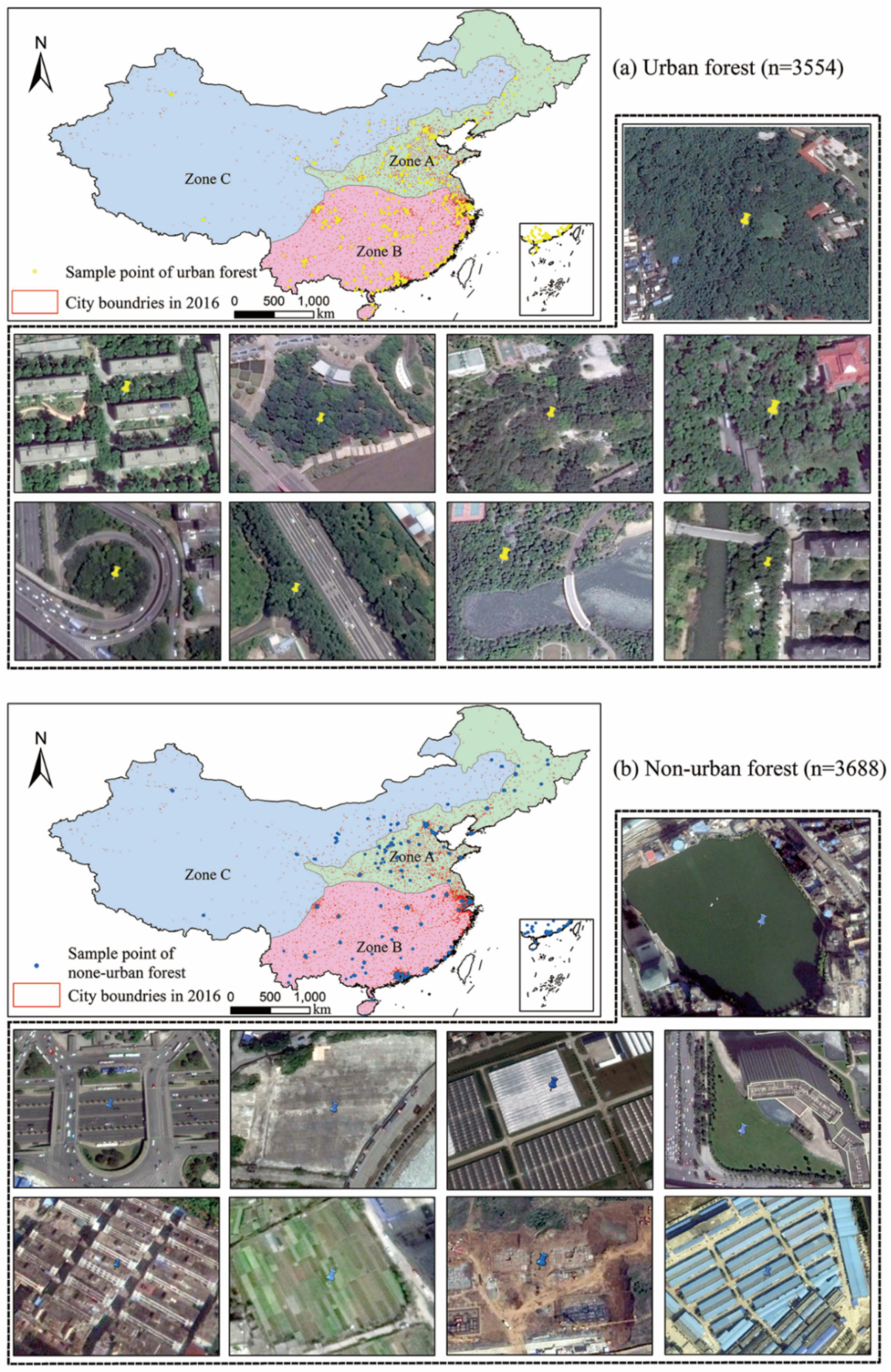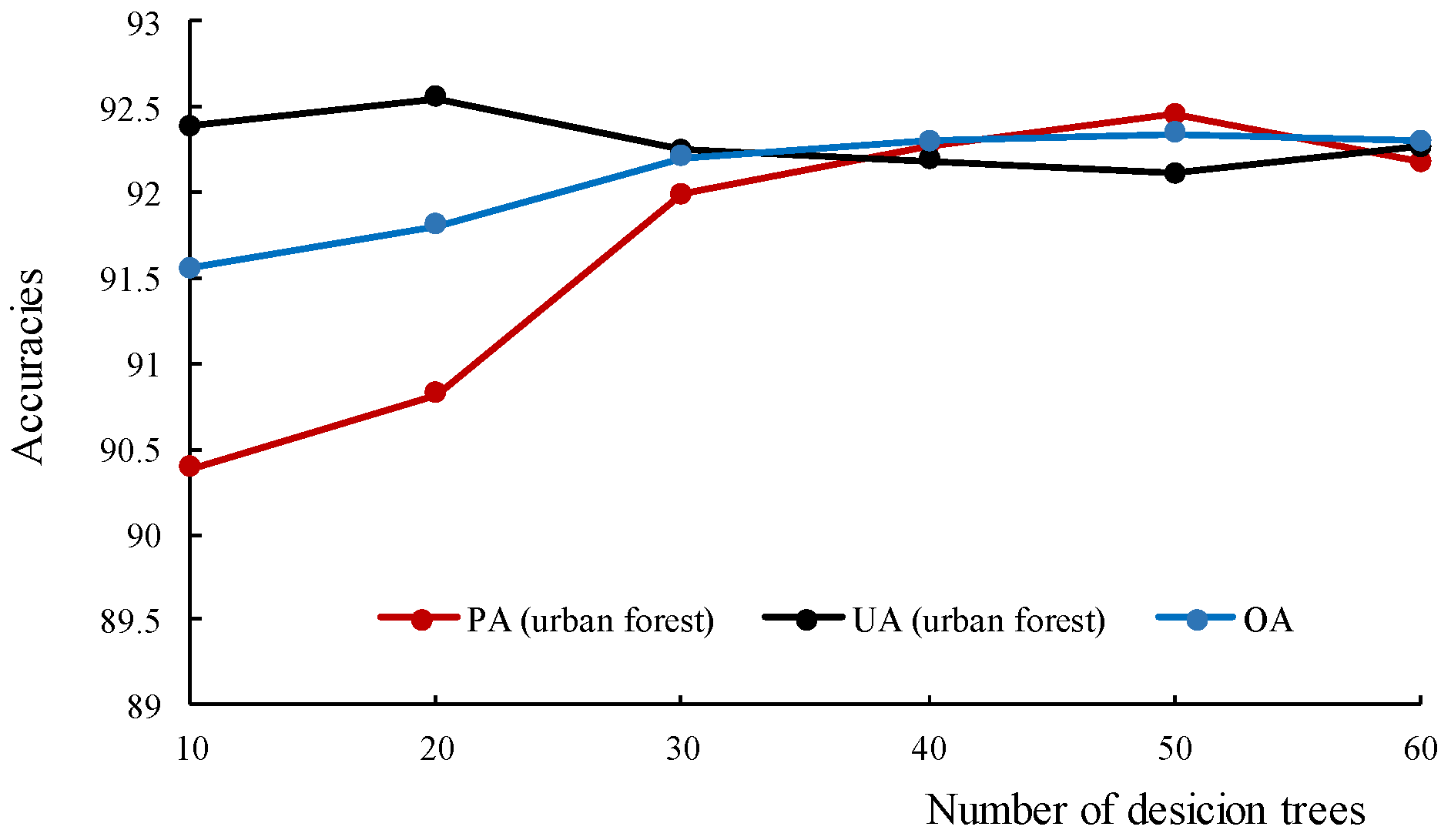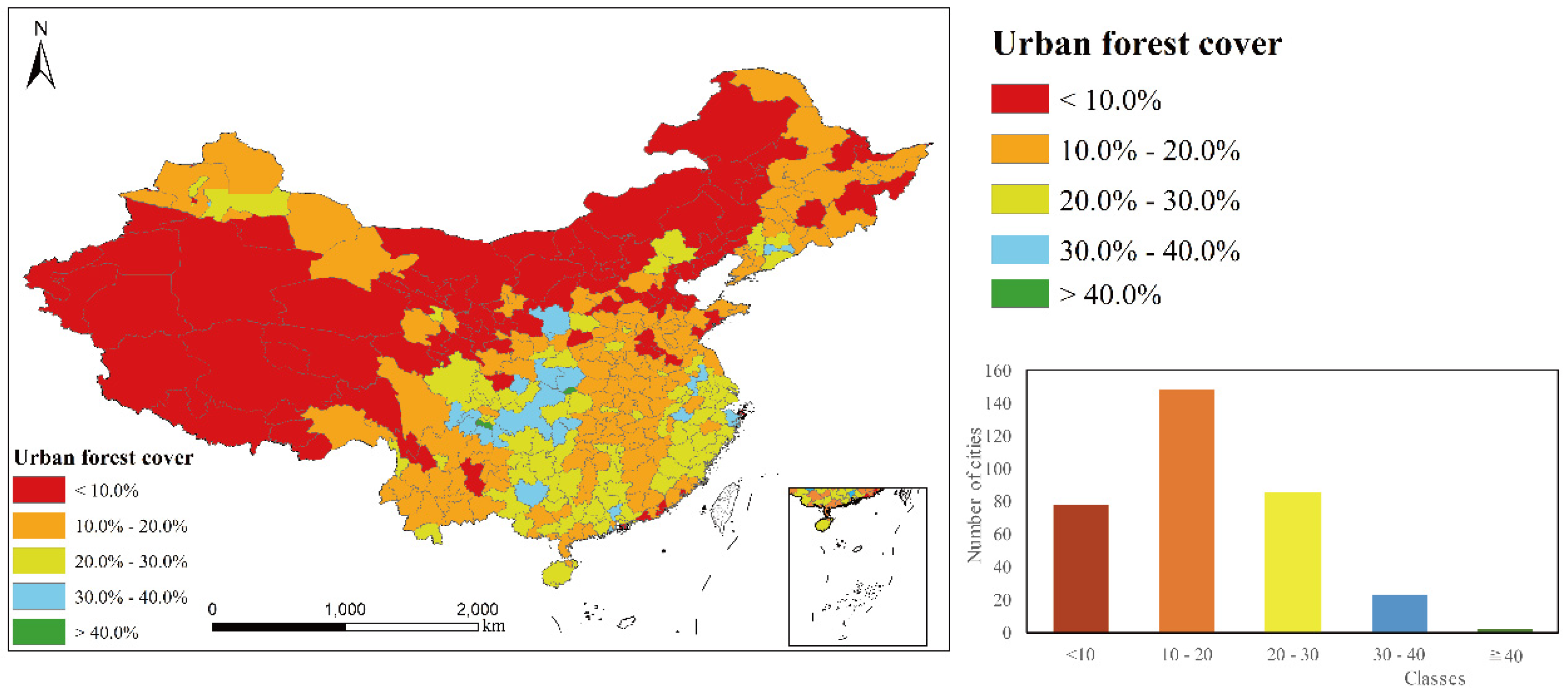Understanding the Spatial Distribution of Urban Forests in China Using Sentinel-2 Images with Google Earth Engine
Abstract
1. Introduction
2. Materials and Methods
2.1. Study Area
2.2. Data
2.2.1. Sentinel-2 Images and Preprocessing
2.2.2. Sample Points for Training and Validation
2.3. Urban Forest Mapping Classifier
- We used the city boundaries of China in 2016 to extract urban area images from Sentinel-2 images, in order to select and train sample points within urban areas for higher accuracy and lower external impact.
- We used an RF classifier to gather knowledge based on training data. The RF classifier is conducive to mapping land cover by mitigating the influence of data noise and overfitting [31,39,40]. It is a non-parametric machine learning method, used to construct multiple random decision trees, each of them possessing several nodes to divide the input pixels into different classes until each node represents every class [41,42]. Comparing the RF classifier with other classifiers, such as “maximum likelihood and single decision trees,” the RF can process higher data dimensions and attain a higher accuracy [34]. Furthermore, it has several tuning parameters, which can affect the efficiency and accuracy of the classification. In this study, these parameters were set by trial and error (Table 1), and by considering accuracy and computing efficiency. As seen in Figure 5, the PA for urban forests and OA increased significantly as the number of decision trees added was below 50; the overall trend of UA for urban forests generally decreased. We also considered the computational efficiency, choosing 40 as the optimum number.
- Suitable bands of Sentinel-2 images were selected to train the RF classifier. In this study, the data input into the RF model included Sentinel bands (B2-B8, B11), NDVI, NDWI, and NDBI [26]. These bands and band combinations achieved the highest accuracy, when compared with other combinations (Table 2). For example, the OA based on these bands (B2-B8, B11) can increase 0.2%, compared with all bands of Sentinel-2 with 10 and 20 m resolution. Among them, NDVI is a vegetation index, that monitors the condition of vegetation [43]; NDWI is sensitive to water bodies [44]; and NDBI can help to extract built-up features [45]. They have been widely used to identify specific classes and as Supplementary Materials for extracting urban forests in this study. The NDVI, NDWI, and NDBI of the Sentinel images were calculated using the Sentinel bands according to the following equations:
- The established RF model was trained to map the urban forest distribution in China and assess the classification accuracy. Based on the above steps, we divided the study area into two types: Urban forest and non-urban forest. The validation data were then used to calculate a confusion matrix and access the OA, PA, and UA. Moreover, the classification results could be assessed by visual inspection at the same time. In training and testing, we started with a small number of sample points, and with an increase in the number of sample points, we assessed the accuracy of these two classification. We then visually evaluated the classification results with reference to the VHR images, randomly, until the results became highly accurate [34].
3. Results
3.1. Accuracy Assessment
3.2. The Distribution of China’s Urban Forests in 2016
4. Discussion
4.1. Reliability of Urban Forest Mapping in GEE
4.1.1. Data
4.1.2. GEE Platform
4.1.3. Efficient Machine Algorithms
4.2. Uncertainties and Limitations
4.3. Suggestions for Urban Forest Construction in China
5. Conclusions
Supplementary Materials
Author Contributions
Funding
Acknowledgments
Conflicts of Interest
References
- Yang, X.J. China’s Rapid Urbanization. Science 2013, 342, 310. [Google Scholar] [CrossRef] [PubMed]
- National-Bureau-of-Statistics-of-China. Statistical Communiqué on the 2018 National Economic and Social Development. Available online: http://www.stats.gov.cn/tjsj/zxfb/201902/t20190228_1651265.html (accessed on 12 May 2019).
- Xu, X.; Xie, Y.; Qi, K.; Luo, Z.; Wang, X. Detecting the response of bird communities and biodiversity to habitat loss and fragmentation due to urbanization. Sci. Total Environ. 2018, 624, 1561–1576. [Google Scholar] [CrossRef] [PubMed]
- Zhou, C.S.; Chen, J.; Wang, S.J. Examining the effects of socioeconomic development on fine particulate matter (PM2.5) in China’s cities using spatial regression and the geographical detector technique. Sci. Total Environ. 2018, 619, 436–445. [Google Scholar] [CrossRef] [PubMed]
- Peng, J.; Ma, J.; Liu, Q.; Liu, Y.; Hu, Y.; Li, Y.; Yue, Y. Spatial-temporal change of land surface temperature across 285 cities in China: An urban-rural contrast perspective. Sci. Total Environ. 2018, 635, 487–497. [Google Scholar] [CrossRef] [PubMed]
- Endreny, T.A. Strategically growing the urban forest will improve our world. Nat. Commun. 2018, 9, 1160. [Google Scholar] [CrossRef] [PubMed]
- Alvey, A.A. Promoting and preserving biodiversity in the urban forest. Urban For. Urban Green. 2006, 5, 195–201. [Google Scholar] [CrossRef]
- Michołap, P.; Sikora, A.; Kelm, M. Variability of bumblebee communities (Apidae, Bombini) in urban green areas. Urban Ecosyst. 2017, 20, 1339–1345. [Google Scholar] [CrossRef]
- Nowak, D.J.; Hirabayashi, S.; Doyle, M.; McGovern, M.; Pasher, J. Air pollution removal by urban forests in Canada and its effect on air quality and human health. Urban For. Urban Green. 2018, 29, 40–48. [Google Scholar] [CrossRef]
- Yang, J.; McBride, J.; Zhou, J.; Sun, Z. The urban forest in Beijing and its role in air pollution reduction. Urban For. Urban Green. 2005, 3, 65–78. [Google Scholar] [CrossRef]
- Armson, D.; Stringer, P.; Ennos, A. The effect of tree shade and grass on surface and globe temperatures in an urban area. Urban For. Urban Green. 2012, 11, 245–255. [Google Scholar] [CrossRef]
- Greene, C.S.; Millward, A.A. Getting closure: The role of urban forest canopy density in moderating summer surface temperatures in a large city. Urban Ecosyst. 2017, 20, 141–156. [Google Scholar] [CrossRef]
- Annerstedt, M.; Östergren, P.-O.; Björk, J.; Grahn, P.; Skärbäck, E.; Währborg, P. Green qualities in the neighbourhood and mental health—Results from a longitudinal cohort study in Southern Sweden. BMC Public Health 2012, 12, 337. [Google Scholar] [CrossRef] [PubMed]
- Nesbitt, L.; Hotte, N.; Barron, S.; Cowan, J.; Sheppard, S.R. The social and economic value of cultural ecosystem services provided by urban forests in North America: A review and suggestions for future research. Urban For. Urban Green. 2017, 25, 103–111. [Google Scholar] [CrossRef]
- Salbitano, F.; Borelli, S.; Conigliaro, M.; Chen, Y. Guidelines on Urban and Peri-Urban Forestry; FAO Forestry Paper No. 178; FAO: Rome, Italy, 2016. [Google Scholar]
- FAO. COFO Side Event on “Urban Forests for Sustainable Cities”; FAO: Rome, Italy, 2016. [Google Scholar]
- Bureau, S.F. Evaluation Indicators for National Forest City. Journey Chin. Urban For. 2007, 5, 7–8. (In Chinese) [Google Scholar]
- CTLA. Guide for Plant Appraisal, 9th ed.; Council of Tree and Landscape Appraiser: Champaign, IL, USA, 2000. [Google Scholar]
- Nowak, D.J.; Rowntree, R.A.; McPherson, E.; Sisinni, S.M.; Kerkmann, E.R.; Stevens, J.C. Measuring and analyzing urban tree cover. Landsc. Urban Plan. 1996, 36, 49–57. [Google Scholar] [CrossRef]
- Fuller, R.A.; Gaston, K.J. The scaling of green space coverage in European cities. Biol. Lett. 2009, 5, 352–355. [Google Scholar] [CrossRef]
- Canetti, A.; Garrastazu, M.C.; De Mattos, P.P.; Braz, E.M.; Netto, S.P. Understanding multi-temporal urban forest cover using high resolution images. Urban For. Urban Green. 2018, 29, 106–112. [Google Scholar] [CrossRef]
- Fan, C.; Johnston, M.; Darling, L.; Scott, L.; Liao, F.H. Land use and socio-economic determinants of urban forest structure and diversity. Landsc. Urban Plan. 2019, 181, 10–21. [Google Scholar] [CrossRef]
- Kulhavy, D.L.; Unger, D.R.; Hung, I.-K.; Zhang, Y. Comparison of AR.Drone Quadricopter Video and the Visual CTLA Method for Urban Tree Hazard Rating. J. For. 2016, 114, 517–523. [Google Scholar] [CrossRef]
- Chen, M.; Dai, F.; Yang, B.; Zhu, S. Effects of neighborhood green space on PM2.5 mitigation: Evidence from five megacities in China. Build. Environ. 2019, 156, 33–45. [Google Scholar] [CrossRef]
- Zhou, Y.; Shi, Y. Towards establishing the conpect of physical urban area in China. Acta Geogr. Sin. 1995, 50, 289–301. (In Chinese) [Google Scholar]
- Liu, X.; Hu, G.; Chen, Y.; Li, X.; Xu, X.; Li, S.; Pei, F.; Wang, S. High-resolution multi-temporal mapping of global urban land using Landsat images based on the Google Earth Engine Platform. Remote Sens. Environ. 2018, 209, 227–239. [Google Scholar] [CrossRef]
- Tan, M.H. An Intensity Gradient/Vegetation Fractional Coverage Approach to Mapping Urban Areas From DMSP/OLS Nighttime Light Data. IEEE J. Sel. Top. Appl. Earth Obs. Remote Sens. 2017, 10, 95–103. [Google Scholar] [CrossRef]
- Song, Y.; Long, Y.; Wu, P.; Wang, X. Are all cities with similar urban form or not? Redefining cities with ubiquitous points of interest and evaluating them with indicators at city and block levels in China. Int. J. Geogr. Inf. Sci. 2018, 1–30. [Google Scholar] [CrossRef]
- ESA. Sentinel-2 User Handbook, ESA Standard Document ed.; European Space Agency: Paris, France, 2015. [Google Scholar]
- Gorelick, N.; Hancher, M.; Dixon, M.; Ilyushchenko, S.; Thau, D.; Moore, R. Google Earth Engine: Planetary-scale geospatial analysis for everyone. Remote Sens. Environ. 2017, 202, 18–27. [Google Scholar] [CrossRef]
- Huang, H.; Chen, Y.; Clinton, N.; Wang, J.; Wang, X.; Liu, C.; Gong, P.; Yang, J.; Bai, Y.; Zheng, Y.; et al. Mapping major land cover dynamics in Beijing using all Landsat images in Google Earth Engine. Remote Sens. Environ. 2017, 202, 166–176. [Google Scholar] [CrossRef]
- Wang, X.; Xiao, X.; Zou, Z.; Chen, B.; Ma, J.; Dong, J.; Doughty, R.B.; Zhong, Q.; Qin, Y.; Dai, S.; et al. Tracking annual changes of coastal tidal flats in China during 1986–2016 through analyses of Landsat images with Google Earth Engine. Remote Sens. Environ. 2018, 110987. [Google Scholar] [CrossRef]
- Chen, B.; Xiao, X.; Li, X.; Pan, L.; Doughty, R.; Ma, J.; Dong, J.; Qin, Y.; Zhao, B.; Wu, Z.; et al. A mangrove forest map of China in 2015: Analysis of time series Landsat 7/8 and Sentinel-1A imagery in Google Earth Engine cloud computing platform. ISPRS J. Photogramm. Remote Sens. 2017, 131, 104–120. [Google Scholar] [CrossRef]
- Teluguntla, P.; Thenkabail, P.S.; Oliphant, A.; Xiong, J.; Gumma, M.K.; Congalton, R.G.; Yadav, K.; Huete, A. A 30-m landsat-derived cropland extent product of Australia and China using random forest machine learning algorithm on Google Earth Engine cloud computing platform. ISPRS J. Photogramm. Remote Sens. 2018, 144, 325–340. [Google Scholar] [CrossRef]
- Jin, X.; Long, Y.; Sun, W.; Lu, Y.; Yang, X.; Tang, J. Evaluating cities’ vitality and identifying ghost cities in China with emerging geographical data. Cities 2017, 63, 98–109. [Google Scholar] [CrossRef]
- China Meteorological Data Sharing Service System. Available online: http://data.cma.cn/data/cdcdetail/dataCode/SURF_CLI_CHN_MUL_DAY_V3.0.html (accessed on 24 August 2019).
- Ministry of Housing and Urban-Rural Development of the People’s Republic of China. 2016 China Urban Construction Statistical Yearbook. Available online: http://www.mohurd.gov.cn/xytj/tjzljsxytjgb/ (accessed on 6 August 2019).
- Congalton, R.G. Accuracy Assessment: A Critical Component of Land Cover Mapping. In Gap Analysis: A Landscape Approach to Biodiversity Planning, Bethesda; Scott, J.M., Tear, T.H., Davis, F., Eds.; American Society for Photogrammetry and Remote Sensing: Bethesda, MD, USA, 1996; pp. 119–131. [Google Scholar]
- Amani, M.; Mahdavi, S.; Afshar, M.; Brisco, B.; Huang, W.; Mirzadeh, S.M.J.; White, L.; Banks, S.; Montgomery, J.; Hopkinson, C. Canadian Wetland Inventory using Google Earth Engine: The First Map and Preliminary Results. Remote Sens. 2019, 11, 842. [Google Scholar] [CrossRef]
- Tian, F.; Wu, B.; Zeng, H.; Zhang, X.; Xu, J. Efficient Identification of Corn Cultivation Area with Multitemporal Synthetic Aperture Radar and Optical Images in the Google Earth Engine Cloud Platform. Remote Sens. 2019, 11, 629. [Google Scholar] [CrossRef]
- Breiman, L. Random Forests. Mach. Learn. 2001, 45, 5–32. [Google Scholar] [CrossRef]
- Belgiu, M.; Drăguț, L. Random forest in remote sensing: A review of applications and future directions. ISPRS J. Photogramm. Remote Sens. 2016, 114, 24–31. [Google Scholar] [CrossRef]
- Chen, J.M.; Cihlar, J. Retrieving leaf area index of boreal conifer forests using Landsat TM images. Remote Sens. Environ. 1996, 55, 153–162. [Google Scholar] [CrossRef]
- McFeeters, S.K. The use of the Normalized Difference Water Index (NDWI) in the delineation of open water features. Int. J. Remote Sens. 1996, 17, 1425–1432. [Google Scholar] [CrossRef]
- Zha, Y.; Gao, J.; Ni, S. Use of normalized difference built-up index in automatically mapping urban areas from TM imagery. Int. J. Remote Sens. 2003, 24, 583–594. [Google Scholar] [CrossRef]
- Zhao, Q.; Zheng, G.Q.; Huang, Q.H. Urban forest remote sensing investigation based on neural network model technology in the main city of Nanjing. Geogr. Res. 2006, 25, 468–476. (In Chinese) [Google Scholar]
- Liu, C.; Li, X. Carbon storage and sequestration by urban forests in Shenyang, China. Urban For. Urban Green. 2012, 11, 121–128. [Google Scholar] [CrossRef]
- Sun, Z.; Xu, R.; Du, W.; Wang, L.; Lu, D. High-Resolution Urban Land Mapping in China from Sentinel 1A/2 Imagery Based on Google Earth Engine. Remote Sens. 2019, 11, 752. [Google Scholar] [CrossRef]
- Chen, W.Y.; Wang, D.T. Urban forest development in China: Natural endowment or socioeconomic product? Cities 2013, 35, 62–68. [Google Scholar] [CrossRef]
- Watkins, S.L.; Gerrish, E. The relationship between urban forests and race: A meta-analysis. J. Environ. Manag. 2018, 209, 152–168. [Google Scholar] [CrossRef] [PubMed]









| Parameter Name | Value |
|---|---|
| Number of decision trees | 40 |
| Number of variables per split | Square root of the number of variables |
| Minimum size of a terminal node | 1 |
| Fraction of input to bag per tree | 0.5 |
| Out-of-bag mode | False |
| Bands | Indices | Overall Accuracy |
|---|---|---|
| B2-B8, B11 | NDVI, NDWI, NDBI | 92.30% |
| B2-B7 | NDVI, NDWI, NDBI | 92.24% |
| B2-B8, B8A, B11-B12(all bands) | NDVI, NDWI, NDBI | 92.09% |
| B2-B8, B11 | NDVI, NDWI | 92.09% |
| B2-B8, B11 | NDVI, NDBI | 92.09% |
| B2-B8, B11 | NDVI | 92.04% |
| B2-B8, B11 | NDWI, NDBI | 91.99% |
| B2-B4 | NDVI, NDWI, NDBI | 91.99% |
| B2-B8, B11 | - | 91.93% |
| B2-B8, B8A, B11-B12(all bands) | - | 91.79% |
| B2-B8, B8A | NDVI, NDWI, NDBI | 91.79% |
| B2-B8, B11 | NDWI | 91.59% |
| B2-B8, B11 | NDBI | 91.54% |
| B2-B8 | NDVI, NDWI, NDBI | 91.54% |
| Urban Forest | Non-Urban Forest | |
|---|---|---|
| PA | 92.27% | 92.33% |
| Omission Error | 7.73% | 7.67% |
| UA | 92.18% | 92.41% |
| Commission Error | 7.82% | 7.69% |
| OA | 92.30% | |
| Kappa coefficient | 0.85 | |
| Reference Data | ||||
|---|---|---|---|---|
| Urban Forest | Non-Urban Forest | Producer’s Accuracy | ||
| Zone A | ||||
| Map data | Urban forest | 403 | 18 | 95.72% |
| Non-urban forest | 39 | 526 | 93.10% | |
| User’s accuracy | 91.18% | 96.69% | ||
| Overall accuracy | 94.22% | |||
| Zone B | ||||
| Map data | Urban forest | 480 | 53 | 90.06% |
| Non-urban forest | 39 | 458 | 92.15% | |
| User’s accuracy | 92.49% | 89.63% | ||
| Overall accuracy | 91.07% | |||
| Zone C | ||||
| Map data | Urban forest | 96 | 11 | 89.72% |
| Non-urban forest | 5 | 15 | 75.00% | |
| User’s accuracy | 95.05% | 57.70% | ||
| Overall accuracy | 87.40% | |||
© 2019 by the authors. Licensee MDPI, Basel, Switzerland. This article is an open access article distributed under the terms and conditions of the Creative Commons Attribution (CC BY) license (http://creativecommons.org/licenses/by/4.0/).
Share and Cite
Duan, Q.; Tan, M.; Guo, Y.; Wang, X.; Xin, L. Understanding the Spatial Distribution of Urban Forests in China Using Sentinel-2 Images with Google Earth Engine. Forests 2019, 10, 729. https://doi.org/10.3390/f10090729
Duan Q, Tan M, Guo Y, Wang X, Xin L. Understanding the Spatial Distribution of Urban Forests in China Using Sentinel-2 Images with Google Earth Engine. Forests. 2019; 10(9):729. https://doi.org/10.3390/f10090729
Chicago/Turabian StyleDuan, Qianwen, Minghong Tan, Yuxuan Guo, Xue Wang, and Liangjie Xin. 2019. "Understanding the Spatial Distribution of Urban Forests in China Using Sentinel-2 Images with Google Earth Engine" Forests 10, no. 9: 729. https://doi.org/10.3390/f10090729
APA StyleDuan, Q., Tan, M., Guo, Y., Wang, X., & Xin, L. (2019). Understanding the Spatial Distribution of Urban Forests in China Using Sentinel-2 Images with Google Earth Engine. Forests, 10(9), 729. https://doi.org/10.3390/f10090729







